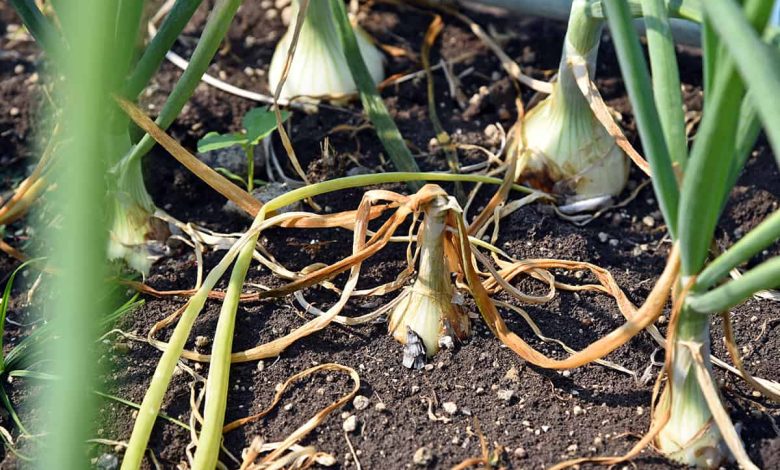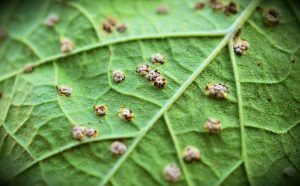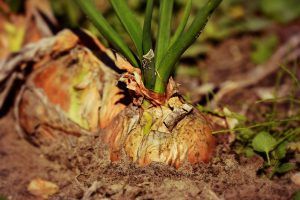Onion Pests and Diseases: [Detection, Causes and Solutions]

 For those who love good cooking, they will know that the onion is one of those essential vegetables.
For those who love good cooking, they will know that the onion is one of those essential vegetables.
This is precisely what has led many of us to include it in home gardens, enjoying the best harvests of its time.
The detail is that it can be a victim of a series of pests and diseases, so you have to be very well informed about the whole subject.
And, to help you in that, here we have gathered the most complete information and that you should not lose sight of in any eventuality.
thrips
 It is a frequent pest in onion crops, especially those that are kept in a range of temperatures between 15 and 20º C.
It is a frequent pest in onion crops, especially those that are kept in a range of temperatures between 15 and 20º C.
They occur in three stages of their biological cycle, the eggs being the most numerous, but the adults being the most harmful to the plantation.
The thrips carry out a process of sucking the sap from the leaves that cause light green spots to appear on them, which later become necrotic.
These conditions in the structure of the leaves function as an entry route for fungi and it is necessary to consider that they are insects that also transmit viruses.
It is necessary to assume that weeds are an ideal home to house thrips, so cultivation areas must be protected from their presence.When working with preventive treatments, these should be started at the time the rise in temperatures is generated.
In addition, they can be combated by applying a good jet of water on the plant or spraying neem oil during the shady hours of the day.
soft rot
 Soft rot is a disease that is generated by the presence of a bacterium that unfavorably changes the texture of the plant.
Soft rot is a disease that is generated by the presence of a bacterium that unfavorably changes the texture of the plant.
Its actions can be seen both in the fields and in the wineries , after the harvest.
The bacterium can come from the land itself where the planting is done, as well as from the irrigation water, and penetrates through wounds that the plant has.
It is also a disease that develops more quickly when temperatures are high , below 3º C they are deactivated.Their main action is on the bulb , which they penetrate through the neck, but it can also affect the entire plant.
The effects, when cutting a plant, will be noticeable because its content will be a little watery and sticky.To prevent the disease from damaging crops, it is very important to keep the area clear of weeds, as well as to control humidity levels .
In fact, this last condition must be maintained even in the storage areas, which must be more or less cold and not very humid.
onion fly
 When it comes to talking about the most complicated pests of onions, the fly is one of the ones that attracts attention most quickly.
When it comes to talking about the most complicated pests of onions, the fly is one of the ones that attracts attention most quickly.
The reason is that it tends to lay its eggs inside the plant, from where the larvae hatch, feeding on the plant almost invisible to our eyes.
As is logical, its feeding causes wounds on the structure, which helps many diseases to lodge in the plant.But if this is not the case, the future is not very encouraging either, since in most cases a bacterial rot ends up that kills the plant.
Its actions do not distinguish between small seedlings and adult plants , causing the latter to lose their bulbs.
The measures to prevent its appearance involve using land with very good drainage to avoid high concentrations of humidity.
It will also be beneficial to associate onion crops with other vegetables that help repel flies , such as cauliflower.Finally, the use of good quality seeds that have been previously treated with insecticides could be decisive in preventing the attack.
Rust
 Onion crops are very susceptible to damage due to the presence of fungi, as occurs in the case of rust.
Onion crops are very susceptible to damage due to the presence of fungi, as occurs in the case of rust.
Its condition is manifested by the formation of small pustules that lodge in the upper and lower part of the leaves.These are brown in color and contain the mycelium of the fungus inside.
Also, they appear in quite a lot.These spores are easily moved by the wind, so care must be taken that the crops are located in an area that does not suffer from constant gusts.
This results in poor overall plant structure, but more worryingly, it affects both the quality and quantity of the harvest .In this case, rust is a disease that preferentially affects those crops that are in the final phase, close to harvest.
To deal with it, there are organic options that offer good results, such as horsetail extract and Bordeaux mixture.
onion miner
 The onion miner initiates damage to crops with its larvae, which are identifiable in gray.These develop and live on the leaves, creating small tunnels or galleries in their structure.
The onion miner initiates damage to crops with its larvae, which are identifiable in gray.These develop and live on the leaves, creating small tunnels or galleries in their structure.
The greatest damage is caused by the larva, a few days before becoming a nymph.
When they are few, the amount of damage to plant structure is not a matter of concern, but when there are many they will cause considerable damage.The main points of action are oriented to the neck and head of the onion , with a notable effect on the crop.
Weeds are the ideal environment for the onion miner to lodge and affect onion crops.
As a protection measure, it is possible to use some natural insecticides, such as nettle purin or neem oil, which will help prevent its appearance.
The most important thing in this whole issue is to control humidity levels since when they are very high, the chances of attack increase.


![Photo of Planting a Banana: Complete Guide [Answer to All Your Questions]](https://www.complete-gardening.com/wp-content/uploads/2022/08/planting-a-banana-complete-guide-answer-to-all-your-questions-390x220.jpg)

